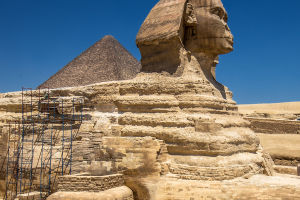
The name "Sphinx" itself comes from Greek mythology, where the creature is described quite differently from the Egyptian version.
In Greek myths, the Sphinx is a monstrous creature with the head of a woman, the body of a lion, and the wings of a bird.
She was said to terrorize the city of Thebes, posing a riddle to anyone who wished to enter. Those who failed to solve the riddle were devoured by her.
The UnXplained: Mysteries of the Sphinx (Season 3)
video by HISTORY
The riddle she posed was as follows: "What walks on four legs in the morning, two legs at noon, and three legs in the evening?" The answer, of course, is a human, who crawls as a baby, walks on two legs as an adult, and uses a cane in old age. The hero Oedipus solved the riddle, causing the Sphinx to throw herself into the sea.
While the Egyptian Sphinx differs in form, its connection to wisdom and riddles in mythology remains strong. The ancient Egyptians saw the Sphinx as a guardian figure, often associated with the sun deity Ra, and it was believed to hold the keys to secrets of the afterlife.
The Egyptian Sphinx: Protector and Symbol of Power
The most famous Sphinx, the Great Sphinx of Giza, is believed to represent the pharaoh Khafre, who reigned during the Fourth Dynasty of the Old Kingdom. The statue’s human head is thought to resemble Khafre's likeness, while the lion’s body symbolizes strength and power. The Sphinx stands as a guardian, watching over the pyramids and the tombs of the pharaohs.
In ancient Egypt, lions were revered as symbols of kingship and divine protection. The Sphinx, therefore, embodied both the intelligence of a human and the might of a lion, creating an image of a ruler who possessed both wisdom and power. The Egyptians also associated the Sphinx with the sun, seeing it as a symbol of the rising and setting sun, and by extension, the eternal journey of the soul.
The Riddle of the Sphinx in Egyptian Context
While the Sphinx in Greek mythology uses riddles to test those who encounter her, the Egyptian Sphinx may not have been a riddle-bearing creature. Instead, it is believed to serve as a spiritual guardian, protecting sacred spaces and guiding the soul of the pharaoh into the afterlife.
The Sphinx was aligned with celestial bodies, and its position in relation to the pyramids may have had astronomical significance. Some researchers suggest that the placement of the Sphinx was designed to represent the path of the sun across the sky, reinforcing its connection to the divine and the cycle of life and death.
The Great Sphinx’s Enduring Mystery
One of the most enduring mysteries surrounding the Sphinx is its age. While conventional history places the construction of the Sphinx at around 4,500 years ago during Khafre's reign, some theories suggest that the Sphinx may be much older. Some scholars argue that the erosion marks on the Sphinx suggest that it may have been weathered by water, which would imply that it was built long before Egypt's recorded history.
This has led to speculations that the Sphinx might be a relic of an ancient, lost civilization, with its true origins hidden beneath the sands of time. Whether this theory holds truth or not, the Sphinx continues to fascinate and mystify, drawing people from all over the world to gaze upon its watchful face.
The Sphinx in Modern Culture
The Sphinx’s image has transcended ancient Egypt, becoming a symbol of mystery and enigma in modern culture. From literature to films, the Sphinx is often depicted as a guardian of secrets or a test of knowledge. Its connection to riddles and its silent, watching presence in the desert have made it a perfect metaphor for the unknown.
In literature, the Sphinx appears as a symbol of wisdom and knowledge, challenging individuals to solve its mysteries. In films and popular media, it often represents an ancient enigma waiting to be unlocked, further cementing its place as one of the world’s most fascinating mythical creatures.
The Timeless Sphinx
The Sphinx, with its captivating blend of human and lion features, continues to be an enduring symbol of ancient Egypt. Whether as a guardian of tombs, a symbol of power and wisdom, or a figure of mystery in mythology, the Sphinx has left a profound impact on both ancient and modern cultures.
Its riddles, its symbolism, and its massive presence continue to intrigue and inspire, making the Sphinx not only a monument to the past but a living legend that transcends time.
The mystery of the Sphinx may never be fully solved, but perhaps that is what makes it so timeless. Its silent gaze, ever watchful over the sands of Egypt, will continue to pose its riddle to the world for generations to come.


